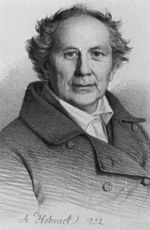Friedrich Wilhelm Argelander facts for kids
Quick facts for kids
Friedrich Wilhelm Argelander
|
|
|---|---|

Friedrich Wilhelm Argelander
|
|
| Born | 22 March 1799 |
| Died | 17 February 1875 (aged 75) |
| Nationality | Prussian |
| Alma mater | University of Königsberg |
| Awards | Gold Medal of the Royal Astronomical Society (1863) |
| Scientific career | |
| Fields | Astronomy |
| Doctoral advisor | Friedrich Wilhelm Bessel |
Friedrich Wilhelm August Argelander (born March 22, 1799 – died February 17, 1875) was an important German astronomer. He is famous for figuring out how bright stars are, where they are in the sky, and how far away they are from Earth.
Contents
Discovering the Stars: Argelander's Life and Work
Friedrich Argelander was born in a place called Memel. This was in the Kingdom of Prussia, which is now Klaipėda in Lithuania. His father was from Finland, and his mother was German.
Early Life and Education
Argelander studied with a famous astronomer named Friedrich Bessel. He became Bessel's helper in 1820. In 1822, he earned his Ph.D. (a high university degree) from the University of Königsberg.
Leading Observatories
From 1823 to 1837, Argelander was in charge of the Finnish observatory. This observatory was first in Turku and then moved to Helsinki. After that, he moved to Bonn, Germany.
In Bonn, he designed and built a new observatory for the University of Bonn. The money for this project came directly from King Frederick William IV of Prussia. Argelander and the King had been friends since they were children. Their friendship began when the King, then a prince, stayed at Argelander's parents' house. This happened when the Prussian royal family had to flee during the Napoleonic Wars.
New Ways to Study Stars
Argelander was very good at finding simple and quick ways to measure stars. He measured their positions and how bright they were. This work was very important for modern astronomy. He also used special tools called heliometers to measure how far away stars were.
He and his helpers used new methods to create huge lists of stars. They also studied stars that change in brightness.
Studying Variable Stars
Argelander was the first astronomer to carefully study variable stars. These are stars whose brightness changes over time. When he started, only a few of these stars were known. He created the modern way of naming and identifying them.
He also made a rough guess about the direction the Sun was moving through space.
Argelander's Star
In 1842, Argelander found that a star called Groombridge 1830 moved across the sky very quickly. This movement is called "proper motion." For many years, it was the fastest-moving star known. Today, it is still the third fastest. For a while, people called it Argelander's Star.
The Bonner Durchmusterung
Argelander, along with Adalbert Krüger and Eduard Schönfeld, created a huge star catalogue. It was called the Bonner Durchmusterung. This catalogue was published between 1859 and 1862.
It listed the positions and brightness of more than 324,000 stars. However, it did not cover much of the southern part of the sky. This was the last star map made without using photography.
Founding an Astronomy Group
In 1863, Argelander helped start an international group for astronomers. This group was named the Astronomische Gesellschaft.
Honors and Legacy
Friedrich Argelander received many awards and honors for his work:
- He became a foreign member of the Royal Swedish Academy of Sciences in 1846.
- He was made a Foreign Honorary Member of the American Academy of Arts and Sciences in 1855.
- He was also elected a Member of the Royal Academy of Science, Letters and Fine Arts of Belgium.
- In 1863, he won the Gold Medal of the Royal Astronomical Society. This is a very important award in astronomy.
- In 1874, he received the Orden Pour le Mérite für Wissenschaften und Künste. This is a high honor for people in arts and sciences.
Many things have been named after him to remember his contributions:
- In 2006, the three astronomy institutes at the University of Bonn were combined. They were renamed the Argelander-Institut für Astronomie.
- A crater on the Moon is named Argelander.
- An asteroid is also named after him: 1551 Argelander.
See also
 In Spanish: Friedrich Argelander para niños
In Spanish: Friedrich Argelander para niños
- Variable star designation


